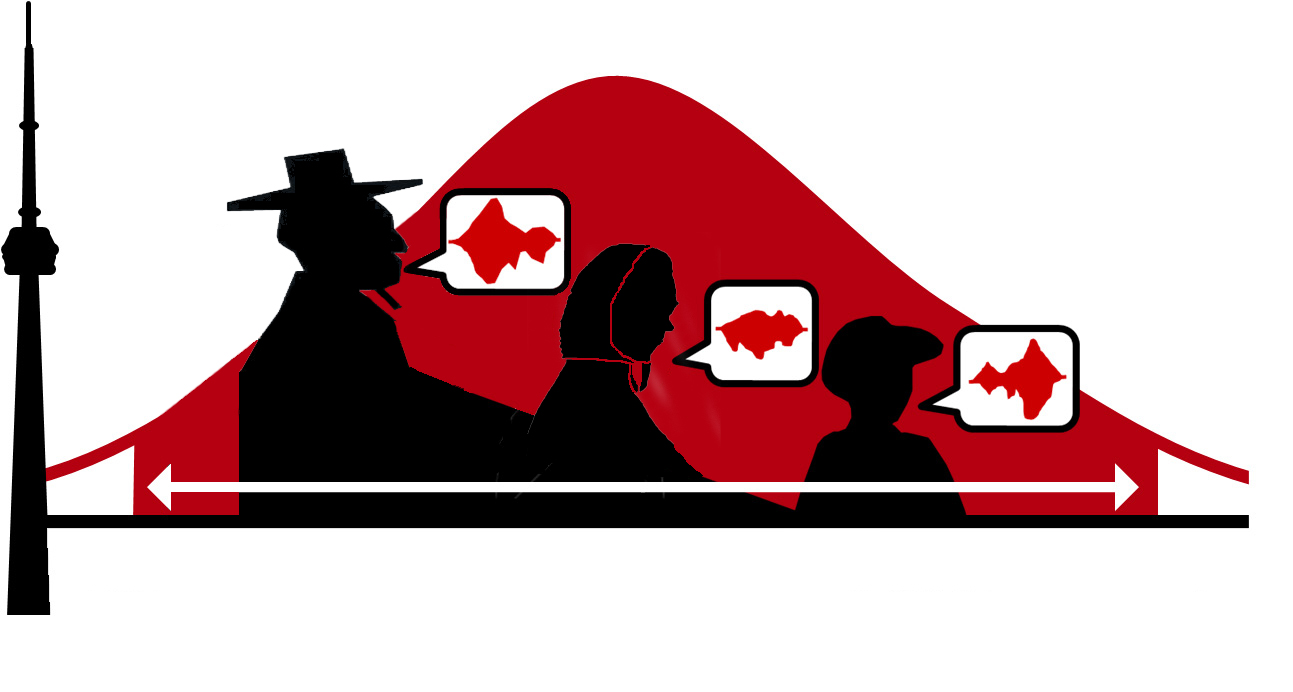Naomi NagyLinguistics at U of T |
|
A Small Study of Sociolinguistic Variation In
this assignment, working individually or in groups of up to 3, you will study
the use of a sociolinguistic variable. You may collect data by means of
participant observation (i.e. by noting relevant examples of the feature you
are studying whenever they are used in your (virtual) presence) or use existing data as specified below. You may choose any one
of the suggested topics to work on, or suggest a variable of
your own after consulting with the
professor. You may use observations from HW_A3.
Step 2. Data Collection
Over
a period of a week, each group member should collect a minimum of 25 tokens (occurrences) of the variable. A good practice
is to keep a notepad with you at all times, so that whenever you hear somebody
using the variable, you can write down which variant they used, as well as
other relevant information about the situation: • gender of the speaker: -
try
to obtain roughly equal numbers of tokens from males and females (and any other gender categories you note) • gender of addressee/hearer (including
yourself) • familiarity of speaker and
addressee/hearer -
distinguish
‘familiar’ interactions (friends and family members) from ‘less familiar’
interactions (acquaintances or those in a formal relationship, such as
student/teacher or employee/employer) -
try
to obtain roughly equal numbers of tokens from familiar and unfamiliar
interactions -
make
note of other features of the context that would make the interaction more or
less formal, such as the topic of conversation and the setting • channel of communication: -
make
note of whether each token occurred over the telephone or internet vs.
face-to-face, through speech vs. writing, through participant observation vs.
questionnaire, etc.
Although Prime Minister Justin Trudeau got a lot of media attention in his first years in office, sociolinguists have yet to publish any analysis of his speech, as far as I know. Many questions come to mind:
To answer one of these questions (or a similar one that the professor has approved, you need to find recorded and/or transcribed speech. This choice depends on what kind of variation you want to examine. You will need at least 3 minutes of speech to examine. Many samples exist online.
If
you/your group is able to work with spoken recordings of one of the languages
in the
(Heritage Language Variation and Change project)
, select a minimum of three
speakers that have been recorded and transcribed. Find at least 25 tokens
(occurrences) of the variable in each recording. A good practice is to create
additional tiers in the ELAN .eaf file and mark and code the tokens there. In
one tier, note which variant they used. In additional daughter tiers, note the other
relevant information about the situation (see list in Option 1). The tokens and
tiers can then be exported to a spreadsheet for easy analysis.
Step 3. Data analysis Summarize
your results in the form of tables, showing what proportion of tokens of each
variant you encountered (e.g., formal vs. informal greetings, -ing vs. -in’) were uttered by males as opposed to females, addressed to
people with whom the speaker was familiar vs. unfamiliar, were spoken over the
telephone vs. face-to-face, etc. Consider carefully how your different variants
might best be grouped together. (e.g., Are some of the greetings more formal
and others more familiar? Are some taboo words extremely taboo and others only
mildly so?) If you identify groupings like this in the data, use them in your
tables. Wherever possible, express your results as percentages, calculating
proportions within each category. For example, what proportion of familiar
greetings were used by men vs. by women? Step 4. Research Report Write
a report (4-5 pages) describing your study. It should include an informative
title and the following short sections in order. Refer to course resources and papers about what should appear in each section, and appropriate style. i)
Introduction State
the variable, what the variants were and why this was interesting or what
general issues it related to (i.e., your goals and hypotheses). ii)
Methodology Describe
how you collected, coded and analyzed the data. iii)
Results Organize
your research findings into tables broken down by social categories (gender,
familiarity, etc.). iv)
Discussion Discuss
your results and their implications. Think about questions that have been
addressed in the class. Make explicit reference to at least two of the assigned
articles, as well as relevant concepts from the textbook. Address questions
such as the following: Do men and women show different preferences for the
various greetings or leavetakings, or pronunciations of -ing? Do men use more strong taboo words than women? Do women use
more information-seeking tags than men do? Do speakers use different greetings
or leavetakings over the telephone than in person? Do people code-switch more
often with people they know well as opposed to those they have limited
acquaintance with? Does pronunciation of -ing
vary with the formality or familiarity of the situation? v)
Conclusion Try
to draw general conclusions about your results. Why did the results come out
the way they did? Why do (or don’t) women and men differ in the use of these
features? Why do speakers use different forms in different interactions? Where
possible, try to identify future areas for possible research. vi)
Bibliography List
all published references, including websites, that you consulted. Cite them
appropriately within your paper. There are resources in the Quercus
portal for help on citation and reference practices. Evaluation Evaluation
of the assignment will be based on the following considerations: Structure: -
organization;
clarity; spelling and presentation (use a
spell-checker!) Content: -
how
well have you defined the variable context (i.e., where does the speaker have a
choice between variants?)? -
how
well have you discussed your methods of data collection? -
how
well have you discussed the details of your quantitative analysis (your social
factors, your calculations)? -
how
well have you made use of tables and graphs? -
how
well have you synthesized and interpreted your results? -
how
well have you made connections between your results and the course materials
(textbook, readings, lectures)? If you work in a group, you
will submit one co-authored paper.
Be sure that the title and all authors' names are listed at the top of page 1. You do not need to create a separate title page. Greetings and/or
Leavetakings When
people encounter one another after a period of not being in each other's
presence, they normally use some kind of greeting (e.g. hi, hello, good morning); similarly, when people
terminate an encounter and expect not to be in each other's presence for some
time, they ordinarily mark this with a leavetaking (e.g. goodbye, see you).
Greetings and leavetakings mark different social relationships between speaker
and hearer. Make note of all greetings and/or leavetakings addressed to you or
to others in your presence and try to characterize the social significance of
each (i.e. which ones are more or less formal, express solidarity or
familiarity, etc.). You may want to divide your greetings/leavetakings into two
variants: ‘formal’ and ‘informal’. Try to characterize any preferences that
different speakers or groups of speakers tend to have (e.g. Do men use informal
greetings more than women?) and whether usage is affected by the channel of
communication (telephone vs. face-to-face). Taboo Words Taboo
words (commonly referred to as "swear words", "curse words"
or "dirty words") are subject to strong social conventions about
their usage. Note all instances of such words that are used in your presence.
You may want to divide the different taboo words into two variants: ‘mild’ and
‘strong’. Try to characterize
whether men and women use taboo words differently and whether people are more
or less likely to use them in the presence of people they know well as opposed
to those they are less familiar with, or in the presence of women as opposed to
men. Tag Questions Robin
Lakoff (1975) has suggested that women use tag questions more than men because
tags signify a desire for confirmation or approval and therefore relative
powerlessness or lack of self-confidence (e.g. It’s a nice day, isn’t it? is supposedly less assertive than It's a nice day.). Collect observations
of male and female speakers using tag questions. You may want to divide the tag
questions into two variants: ‘polite/deferential’ and ‘seeking confirmation’.
Note especially when the tags are used differently from the way you would use
them. In your analysis, discuss whether your data confirm Lakoff’s hypothesis
or not; i.e. do men and women use these forms with different frequency or
different significance? -in/ing The
-ing suffix in English (e.g. building, running, opening) is
sometimes pronounced as 'ing' and sometimes as 'in' (known as "dropping
the 'g'"). Since the social evaluation of each pronunciation is different,
speakers often vary their usage according to formality, and speakers of
different social backgrounds may show different overall rates of usage. Data
collection for this feature requires close attention to phonetic detail:
practice listening to the pronunciation of -ing
words in conversation before you begin collecting data. (When you begin writing
down your observations, they will probably occur so frequently that you will be
able to collect enough data to work with in a day!) Therefore, try to observe
people from a range of social backgrounds. In
addition to social variation, this variable is also subject to an interesting
linguistic constraint. To examine this, you should classify each example you
observe as to whether it was used as a noun (e.g. the building across the street, running is fun) or a verb (e.g. we're building a house, he's running to work). Your analysis
should address the following questions: Is there a sex difference in the usage
of the two pronunciations? Do speakers shift towards increased use of one of
the pronunciations in more formal situations (e.g. lectures) as opposed to
informal ones (e.g. casual conversation)? Is there any such shifting depending
on the sex of the addressee or the channel of communication? In the Heritage Language (HLVC) Corpus
You could examine things like:
|



